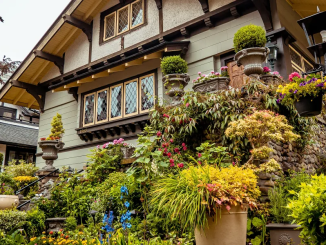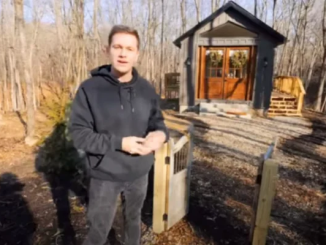“I look at my role as being a friend of Canberra Hospital, I can bring some pleasure and happiness sometimes to people who are really in difficult times in their lives.”
With backing music from a Bluetooth speaker, Sayer croons his way around the cancer wards, making a human connection with everyone he comes across.

Canberra Region Cancer Centre Operations Manager Caroline McIntyre says Sayer’s visits are typically kept a surprise for patients and staff.
“He’s always come in so discreetly,” she says.
“Normally it’s just very quiet, he comes up in the back lift and says hello to literally everybody.
“Some of them are doing it tough, and to have a little bit of joy and light – it really gives them a lift.
“What makes me happy is to see people getting chemo on their feet dancing.”
Jamming with Jimi Hendrix, Countdown and the Troubadour
Originally a graphic designer by trade, English-born Leo Sayer rose to pop prominence in London in the late 1960s, as a singer-songwriter – and was soon adopted by Australia as an honorary son after his first tour here in 1974.
He went on to become an Australian citizen in 2009.
Sayer was a regular on ABC TV’s Countdown during the 70s and 80s, performing chart-toppers like “You Make Me Feel Like Dancing”, “When I Need You”, “More Than I Could Say” and “Orchard Road”.

He blushingly admits they were wild days – when he didn’t always live up to his “good-guy” public persona.
“It was mad, I mean, Top of the Pops in England, Countdown over here,” he says.
“You were mobbed by the fans, I remember being dragged out of a limousine the first tour that I came here, and then speaking to crazy people like Molly Meldrum on TV and trying to sort of like take it all in.”
It seems hard to believe – the petite, well-spoken singer, with a mane of curly hair that inspired changing his name from Gerard to Leo – beating off mobs of screaming fangirls.
Sayer circulated in superstar company, becoming close friends with former Beatles George Harrison and Paul McCartney, collaborating with Roger Daltrey of The Who, and even sharing a sly cigarette or two with John Lennon and Yoko Ono who had a flat above his design studio.
“I met Jimi Hendrix right at the start of his career. I actually jammed with him, playing the harmonica, and him playing the guitar,” he says.
Recalling his 1975 opening night at the famous Troubadour Club in Los Angeles, he looked up to see an intimidating line-up of fans in the front row.

“It was David Bowie, Elton John, and ‘The Fonz’ [Henry Winkler].”
Alongside them: John Cleese, Mick Jagger, Bernie Taupin, and comedian Marty Feldman.
“We never thought it would last, we were adapting to things around us, writing songs about things that are around us,” he says.
“And we thought they were only for our generation — so the amazing thing is my music’s become like a fine wine, where you lay it down and years later, it becomes a collector’s item.
“We’re in an age where the music that I make, young kids are actually latching onto it now, and they’re finding that that generation and that style of music we made is as current now as anything.”
Sayer’s health battles, still spreading hope at 76
Leo Sayer says his hospital charity work caps off a career dedicated to providing joy through music.
“It’s a nice piece of synchronicity really, because I was born in the grounds of a hospital in Shoreham by Sea in Sussex, near Brighton in England,” Mr Sayer said.
“I suppose I’ve always felt comfortable in hospitals and being around hospitals.
“Growing up, my dad was a hospital engineer, Mum was a nurse, my sister was a matron.”

Sayer has health struggles of his own, including three stents in his heart, which help him have a genuine connection to the hospital patients he entertains.
“[My music] is providing something that isn’t taking away from any of the treatment that’s going on. It’s providing something that’s just putting a smile on peoples’ faces.
“Music is communication and that’s what this is all about, we’re communicating, we’re making people feel better.
“We’re not healing people with music, but we are making them feel better about their healing.
“To sell out Canberra Hospital will do me fine.”
Breastfeeding in Public: A Mother’s Creative Response

Although there has long been discussion around breastfeeding in public, one instance from 2018 still has an impact on moms all over the nation. When Melanie Dudley, a new mother from Texas, breastfed her three-month-old son at a restaurant, she became the talk of the town. The following events are both humorous and thought-provoking.
It was 86 degrees outside, and Melanie was covertly nursing her infant. But a man seated close to her felt uneasy and requested her to cover up. Melanie answered with a twist that made everyone in the restaurant laugh, refusing to become defensive. Laughter from bystanders as she covered her own head with the nursing cover.
Melanie’s unorthodox approach was captured in a photo that rapidly went viral on Facebook, igniting a national dialogue about nursing in public. The tragedy happened in 2018, yet its significance is still relevant today. It draws attention to the current discussion over a mother’s unrestricted right to breastfeed her child.
In addition to showcasing Melanie’s sense of humor, her innovative technique brought attention to an important topic: respecting women’s autonomy and the natural act of breastfeeding. It serves as a reminder that society need to encourage and support moms as they face the difficulties of parenthood.

Breastfeeding is a lovely, organic process that has many advantages for both mother and child. Regardless matter where they are, it is imperative to provide a space where moms feel at ease caring for their infants. Promoting the wellbeing of moms and their infants requires providing support and understanding.
Thus, let us honor the bravery and tenacity of every breastfeeding mother out there. They should be commended for their commitment and love, not condemned. Breastfeeding is a journey that ought to be celebrated and embraced rather than kept secret.
Let’s keep pushing for the right to breastfeed in public and making sure that all mothers experience support and empowerment. We can all benefit from a more accepting and understanding society if we work together.



Leave a Reply